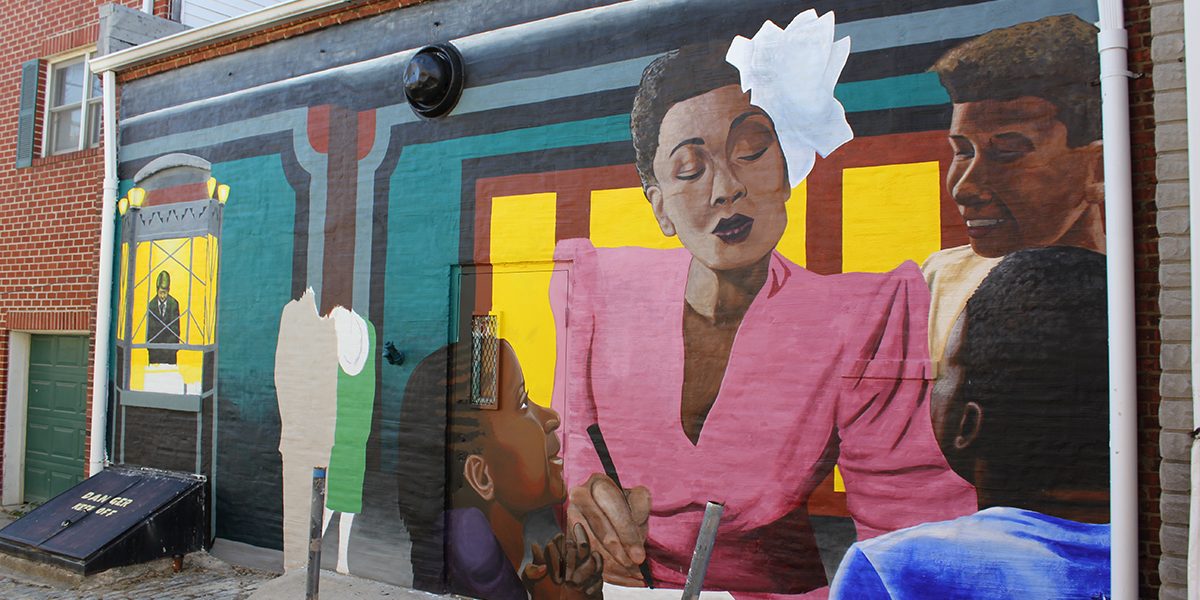News & Community
The Chatter: June 2015
Overheard at the Baltimore Museum of Industry, Billie Holiday's birthday, and Camden Yards.
Working Girls
Key Highway
March 15, 2015
“It was a serious time for everybody, and I took my job very seriously,” Grace Henninger tells the Baltimore Museum of Industry’s packed auditorium, describing how she helped build B-26 bombers at the Glenn L. Martin Company factory during World War II. “I learned right away that if you were working the rivet gun, that bracket had to be held very tight. Very little re-work had to be done on my end,” the fit, blue-eyed 90-year-old says in a North Carolina drawl. “I loved my United States of America.”
At its peak, the Middle River aviation manufacturer employed 55,000 workers—one-third young women like Henninger and fellow panelist Elsie Arnold, the Rosie the Riveter Association’s Baltimore Chapter president. Raised on a 500-acre farm, Henninger had followed an aunt to Charm City. Starting at 19, Arnold worked at Glenn L. Martin for two-and-a-half years, saving for nursing school. “The boys had left for war and the women took over,” smiles Arnold, who went on to a 40-year career at the Greater Baltimore Medical Center. “But we didn’t think of ourselves as pioneers.”
Later, Henninger recalls meeting her future husband, home on leave, while shopping at the Essex A&P. They married six weeks later—almost 70 years ago. After his discharge, they bought a four-room house initially intended as temporary housing for plant workers in Victory Villa, a development where the streets were given names like Fuselage Avenue and Altimeter Court. “There were extensive renovations over the years, and we raised our five children in that house,” says Henninger, who also worked on the assembly line at Westinghouse for 20 years after her children had grown. “My husband Jim died in 1999 from colon cancer from the asbestos at Bethlehem Steel. I still live in that house.”
Birthday Blues
South Durham Street
April 10, 2015
In an open garage, accompanied by her quartet, Baltimore’s Rhonda Robinson, in heels and pearls—gold flower tucked in her hair—belts out the song most associated with the legendary jazz singer who grew up in this cramped alley.
“Lady sings the blues
She tells her side, nothing to hideNow the world will know
Just what the blues is all about”
Up at the corner, there’s a beautiful, towering, three-story-high mural of a full-throated Billie Holiday—her back turned away, appropriately, from her difficult childhood home—singing out to Upper Fells Point and far beyond. The painting by artist James Eichelberger is so perfectly executed that the century-old building’s narrow drainpipe has been seamlessly transformed into a throwback standing microphone. And today, with a block party commemorating her 100th birthday, Holiday’s music pulls passersby down the alley where she grew up. “It’s bouncing off the row houses and going up the street,” says Ian Craig, who lives above the garage where Robinson is performing. “People are walking past, hearing the music, and joining in.”
Long run-down, Holiday’s childhood alley has been reborn since the local improvement association won a $30,000 PNC Transformative Art Prize to create a tribute to “Lady Day.” So far, five murals, a mosaic, and 11 painted screens pay homage to the singer, and, coinciding with her birthday, neighbors have hosted tours this week. “You hear that voice once, and you never forget,” says Leo Arreaza, 46, who now lives in Baltimore, but is from Caracas. “I’m from Venezuela, and when I was a kid my parents played her records all the time.”
No Silent Spring
Eutaw Street
April 29, 2015
As leadoff man Alejandro De Aza steps to the plate, the unmistakable, and on this day, wholly surprising sound of the Orioles’ rallying cry echoes through Camden Yards. For the first time in major league history, there isn’t a single fan at a game. Not officially, anyway. This afternoon’s contest is closed to the public following protests in the wake of 25-year-old Freddie Gray’s death in police custody. However, two-dozen vociferous fans are stealing glimpses of the action outside the center-field gates, letting the Orioles know they’re not quite alone.
“Give me an ‘O,’ Give me an ‘R’ . . . “
In fact, the strange thing is not what isn’t heard, but what is—everything. When a White Sox batsman hits a hard grounder to O’s second baseman Rey Navarro, the ball can literally be heard smacking into gloves around the infield for an inning ending, 4-5-3 double play. Players can be heard calling for fly balls and clapping from the bench.
During the pregame press conference, O’s manager Buck Showalter had joked about umps catching the normally unheard “sweet nothings” emanating from the dugout. Afterward, he jokes again about the starting pitcher hearing the bullpen phone ringing. But when asked what advice he has for Baltimore’s young black men, Showalter strikes a serious tone. “I’ve never been black, okay? So I don’t know,” he begins. “I can’t put myself there. I’ve never faced the challenges that they face. . . . It’s a pet peeve of mine when somebody says, ‘Well, I know what they’re feeling. Why don’t they do this?’ . . . You have never been black, okay? So just slow down a little bit.”
